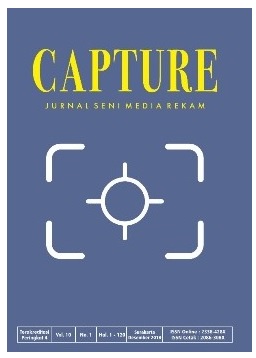IMPLEMENTATION OF THE NETWORK STATION SYSTEM ON TVRI BALI
DOI:
https://doi.org/10.33153/capture.v12i1.3030Keywords:
SSJ, subnetwork, TVRI BaliAbstract
The democratization of broadcasting in Indonesia is manifested in the implementation of the Network Station System (Sistem Stasiun Jaringan / SSJ) by striving for diversity of ownership and broadcast content in broadcasting institutions. SSJ is also an effort to decentralize broadcasting so that people in the regions get information related to their own regions through subsidiary networks or local broadcasting institutions. TVRI is the only public broadcasting institution that has network subsidiaries throughout Indonesia. This research uses a case study approach, an approach to intensively examine a case with a focus on TVRI Bali. Data collection used interview and observation methods. Data analysis using the Interactive Analysis approach. The results showed that TVRI Bali has not been able to fully implement SSJ. TVRI Bali can only meet the provisions of local broadcast content with a percentage of up to 20%, but has not been able to fulfill the spirit of diversity of ownership according to the basic concept of SSJ. In addition, the principle of diversity of ownership has not been fulfilled due to inconsistencies between the Broadcasting Law and Government Regulation Number 13/2005 and Ministerial Regulation 43/2009 which specifically regulates private television broadcasting institutions.
Downloads
References
Aji, G. G. (2014). Spasialisasi Media dan Demokratisasi Penyiaran Implementasi Sistem Siaran Televisi Berjaringan di Indonesia. Semiotika, 8(2), 131-.
Ama. (2018). TVRI Bali Go Internasional, Jadi Daya Tarik Adat dan Pariwisata. Jarrakpos. Retrieved from https://jarrakpos.com/17/07/2018/tvri-bali-go-internasional-jadi-daya-tarik-adat-dan-pariwisata/
Amanda Gelgel, N. M. R., Dewi Pascarani, N. N., Sugiarica Joni, I. D. A., Cahyani, D. Y., & Pradipta, A. D. (2014). Profil Demografis dan Psikografis Pemirsa Siaran TVRI di Bali [Laporan Penelitian]. Denpasar: Universitas Udayana. Retrieved from Universitas Udayana website: https://simdos.unud.ac.id/uploads/file_riwayat_penelitian_1_dir/cad40e7e774049d5e24564b4967b8c82.pdf
Amelia, C. R., & Sugihartono, R. A. (2011). Pengaruh Sajian Program Berita TATV terhadap Kebijakan Pemkot Surakarta dalam Memilih Media Publikasi. CAPTURE : Jurnal Seni Media Rekam, 3(1), 28–36. doi: https://doi.org/10.33153/capture.v3i1.645
Aminudin, A. (2016). Implementasi Regulasi Sistem Stasiun Jaringan (Analisis Ekonomi Politik Media pada RCTI Network Banten). Communication, 7(1), 47–62.
Budiman, A. (2012). Sistem Penyiaran Televisi Berjaringan. Info Singkat: Pemerintahan Dalam Negeri, IV(3). Retrieved from http://berkas.dpr.go.id/puslit/files/info_singkat/Info%20Singkat-IV-3-I-P3DI-Februari-2012-20.pdf
Hendrawan, B. (2013). Televisi Lokal: Antara Kepentingan Korporat dan Fungsi Sosial. Jurnal Komunikasi Indonesia, 2(1), 5–14.
Juditha, C. (2015). Televisi Lokal dan Konten Kearifan Lokal (Studi Kasus di Sindo TV Kendari). Jurnal Penelitian Komunikasi Dan Pembangunan, 16(1), 49–64.
Nursatyo. (2016). Dinamika Interaksi Agen dan Struktur dalam Mencegah Konsentrasi Kepemilikan Media Televisi. Komuniti: Jurnal Komunikasi Dan Teknologi Informasi, VIII(1), 64–81.
Primasanti, K. B. (2009). Studi Eksplorasi Sistem Siaran Televisi Berjaringan di Indonesia. Scriptura, 3(1), 85–102.
Sahadewa, A. A. G. R. (2019). Wawancara Komisioner Komisi Penyiaran Indonesia Daerah (KPID) Bali.
Sugihartono, R. A. (2009). Televisi Lokal sebagai Medium Pencitraan Lokalias Daerah. ACINTYA: Jurnal Penelitian Seni Budaya, 1(1), 1–15. doi: https://doi.org/10.33153/acy.v1i1.17
Supadiyanto. (2015). Implementasi Program Siaran Lokal pada Stasiun Televisi di Daerah Istimewa Yogyakarta. Jurnal An-Nida, 7(2), 65–78.
Uleng, A. A. D., & Mau, M. (2016). Identitas Lokal vs Sentralisasi Udara Radio Berjaringan di Kota Makassar. KAREBA: Jurnal Ilmu Komunikasi, 5(1), 1–14.
Wahyuni, D., Cangara, H., & Nadjib, M. (2014). Manajemen dan Kebijakan Operasional Televisi Nasional Berbasis Lokal di Kota Makassar. KAREBA: Jurnal Ilmu Komunikasi, 3(3), 210–217.
Wijaya, J. (2019). Wawancara Kepala Pengembangan Program dan Pengembangan Usaha TVRI Bali.
Downloads
Published
Issue
Section
License
Copyright (c) 2020 Muliarta Mul Nengah

This work is licensed under a Creative Commons Attribution-ShareAlike 4.0 International License.
Copyright
Authors who publish with Capture: Jurnal Seni Media Rekam agree to the following terms:
- Authors retain copyright and grant the journal right of first publication with the work simultaneously licensed under a Creative Commons Attribution License (CC BY-SA 4.0) that allows others to share the work with an acknowledgment of the work's authorship and initial publication in this journal.
- Authors are able to enter into separate, additional contractual arrangements for the non-exclusive distribution of the journal's published version of the work (e.g., post it to an institutional repository or publish it in a book), with an acknowledgment of its initial publication in this journal.







